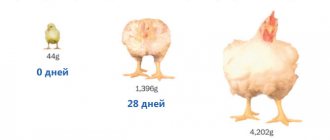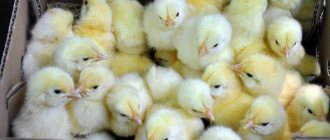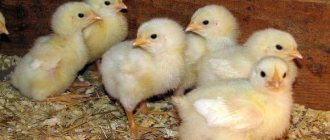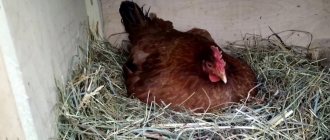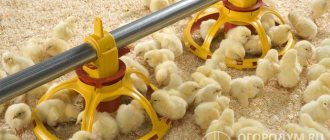Good afternoon, novice poultry farmers and those new to poultry breeding. Raising broiler chickens at home for beginners from scratch, tips from A to Z in our material. The chicken is one of the first birds domesticated by humans many hundreds of years ago. First of all, people were interested in its egg production, which is why it was grown for centuries.
But these poultry are also raised for their tasty, tender dietary meat. As a result, two types of breeds of these individuals were formed - with egg and meat productivity. There is a third category of chickens - with meat and egg productivity, but the egg production and meat production rate of representatives of this category is lower than that of egg and meat breeds.
Advantages of broiler breeds
Broiler breeds are raised exclusively to quickly produce tasty, tender meat. Typically, these individuals are raised for a couple of months, during which time they gain sufficient weight. But the meat has excellent taste.
Further raising of broilers is unprofitable. They start eating a lot! But the mass increases much more slowly than in the first two months.
Some novice poultry farmers leave females aside in the hope of getting a sufficient number of eggs from them, but this is a vain hope - broiler chickens practically do not lay eggs, since they are not designed for this.
In just one year, you can get no more than 100-120 eggs from one broiler chicken, and they eat a lot of feed during this period. And their weight stops actively increasing after the first year of life, and when they are slaughtered, the owners discover that more fat has formed in the carcass than pure meat.
Therefore, simple calculations show that the most profitable is to slaughter broilers at the age of 2-2.5 months, no more.
External characteristics
Scientists have worked hard to create several lines with different external characteristics. But, birds generally differ only in color. There are many varieties. Due to this feature, chickens are often also called “colored broilers”. Here are some of the most common varieties.
Some birds have bare necks, but most are fully feathered. The plumage is rigid, quite dense and voluminous. Birds have a powerful physique. They have a wide body, squat, low-slung.
Pronounced belly and chest, as well as a flat back. The body is horizontal, on low paws widely spaced from each other.
The head is small and not unique in any way - with a regular, leaf-shaped crest that is slightly larger than many other varieties. The face, earrings and beak are red. The eyes are red-orange or amber.
The maximum weight that can be expected from roosters is about 5 kg, and hens usually weigh 800-900 grams less. But, it should be borne in mind that weight indicators also differ among different lines of this breed.
Work on the variety continues to this day. The company that deals with it continues to improve the birds. We can definitely say that their character is quite calm - the winged flock is not prone to aggression, is peaceful, but often suffers from stress.
Due to excessive timidity, the quality of the masonry may deteriorate. But they are raised mainly for their carcasses, so there are no problems due to timidity.
Broiler breeds with photos and descriptions
Now about the most popular breeds of meat chickens - broilers - chickens for growing at home.
This article discusses the possibility and advantages of raising broilers at home. For personal consumption, beginners from scratch can breed the following chickens for meat and egg production:
- Brahma;
- Cochin;
- Faverol and a number of others.
For more information about them, see the links. They are not as picky as broiler chickens. If you have no experience, start raising chickens for meat with them. But they won't grow in a couple of months! They will have to be fed for 5-6 months. They are big, but not broilers.
These breeds are characterized by the following qualities:
- The sizes of individuals are quite large - up to 5 kg;
- low egg production;
- the ability to quickly gain weight.
For home breeding, breeders offer poultry farmers the following crosses and other breeds of broiler chickens:
Ross 308.
These chicks actively gain weight in the first months after birth - in the first month they are able to gain a weight of 2.5 kg. These chickens are viable, do not require any special dietary requirements, and are unpretentious to living conditions.
Cobb 500.
These broilers do not require expensive feed for feeding; a month after birth, they gain a couple of kilograms in weight with a normal diet. They are distinguished by their unpretentiousness and endurance.
Broiler-M.
It is distinguished not only by excellent meat productivity and good egg production, which is not typical for broilers. In a few months it gains a weight of 3 kg, and broiler hens can lay up to 150 eggs per year.
There are a lot of broiler chickens! See this link for a description with photos of the most popular crosses among our poultry farmers.
Broiler chicken breeds have many advantages, which is why they are successfully raised not only on small farms, but also on an industrial scale.
Recommendations for selection
Let's look at a few features that should be taken into account when choosing broilers:
- The breed of broiler should be selected according to personal needs. For example, if you want to get both meat and eggs, it makes sense to buy meat and meat-egg broilers (each breed has its own “function”). Another example is that for the needs of meat farms it is recommended not to purchase meat-egging breeds, since they produce less meat.
- It is recommended to buy eggs or small chicks from trusted breeders. The main breeders are large meat farms that operate on the B2B market (that is, they sell products not only to private farmers, but also to other farms). Don’t be shy to ask the breeder for a certificate that confirms the breed.
- If you buy chickens, choose calm ones. But please note that chicks should not be lethargic as this may be a sign of a hidden infection. After bringing the chickens home, it is recommended to keep them for 1 week in a separate cage for the purpose of prevention.
Attention! If many clings die after being brought home, it makes sense to send a complaint to the breeder. Many breeders do not like to lose clients, so there is a high probability that they will give out new individuals for free.
Raising broiler chickens without loss
When raising such birds at home, it is necessary to prepare a separate room for them. Typically, broilers are raised on the floor at home, so the coop should be prepared before purchasing or hatching broiler chickens.
The floor in the room should be cleaned and disinfected, then a layer of lime is laid on it, and on top - a thick layer of sawdust or wood shavings. Such litter should always remain dry, loose and clean.
The humidity in the chicken coop should be no higher than 60%, and the temperature should be about 25 degrees Celsius. After chickens are placed in the house, the temperature should be raised to 35 degrees.
No more than 12 chicks should be placed per square of area. After about 30 days, the temperature in the chicken coop is lowered to 18-19 degrees Celsius.
You can also keep broiler chickens in cages. But usually this method is used when raising poultry in poultry farms, where a large number of broilers are raised at the same time.
For such cultivation, specially equipped cells are prepared. As a result, space is saved (if the chicken coops are small), and there is no need for bedding on the floor. If necessary, the cells are installed on top of each other - in tiers.
Subject to hygiene and sanitary standards, broiler chickens kept in this manner grow healthy and gain weight faster, as they practically do not move. The microclimate when raising chickens in cages is the same as when kept on the floor.
Content Features
Chicks and adult broilers are kept both in cages and on the floor. In both cases, it is necessary to observe planting density, temperature and light conditions, humidity and nutritional characteristics for each age period.
Chicken crosses: how do they differ from breed and hybrid?
Read
Is it possible to keep chickens in SNT, a private house, a city, or a country house?
Answer
Why do chickens peck each other until they bleed and what to do about it?
Causes of pecking
Feeding broiler chickens
To quickly gain weight, such chickens need to be provided with high-quality feed in sufficient quantity. It is dangerous to underfeed broilers - they will lag in growth, begin to weaken and may die.
A day after birth, 1 drop of Trivit is dripped into the chicks’ beaks. Repeat this procedure after a couple of days.
In the first week, the chicks need to be fed up to 8 times a day at intervals of 2 hours. For this, it is recommended to provide special starter feed (for broiler chickens). You can also include small store-bought cereals in your diet. Also included in the food:
- boiled egg;
- milk (or skimmed milk);
- cottage cheese.
After 7 days, crushed corn and wheat can be added to the main diet.
And after 10 days, broiler chickens are transferred to a vitamin-grain complex, which must contain:
- corn grits – 10%;
- crushed wheat – 25%;
- barley bitch – 10%;
- oat flakes – 5%;
- nettle – 10%, it is first doused with boiling water and finely chopped.
After 14 days, you can add grated carrots and boiled meat to the daily menu of broiler chickens. Also, containers with chalk, fine gravel, bone meal and shells are placed next to the feeders.
Drinkers must be installed next to the feeders. Chickens should not be given raw cold water. It is recommended to prepare decoctions of chamomile and rose hips, which have a beneficial effect on the digestive system of chicks.
Important! The water in drinking bowls must be constantly clean.
Chicks consume large amounts of moisture - every day one chick needs at least 40 g of water. If there is not enough fluid, the young animals may experience health problems.
From about the fourth week of life, broiler chickens can begin to be fed with “adult” feed, and there should be food in the feeders constantly. The diet must include:
- wet mash;
- a large amount of greenery.
Possible diseases
Despite the resistance of most broiler varieties to various diseases, the risk of their development cannot be excluded.
Most often, broilers suffer from chicken diseases such as:
Coccidiosis
With this disease, damage to the gastrointestinal tract occurs. When coccidiosis occurs, chicks experience diarrhea and feces that are yellow or green in color. The birds' weight is rapidly decreasing. The disease is characterized by a high mortality rate.
For treatment and prevention, the drugs Coccidiovit and Baykoks are used, which are added to drinking water or mixed feed. To prevent the development of coccidiosis, it is necessary to maintain sanitary and hygienic standards.
Bronchopneumonia
This disease is one of the most dangerous deviations that pose a threat to the life of birds. Bronchopneumonia usually occurs against the background of severe hypothermia. Characteristic signs of the disease: difficulty breathing with wheezing, cough, rhinitis, lack of appetite, poor condition of feathers.
The disease is treated with antibiotics. The drugs Gentamicin, Tetracycline, Levomycetin are prescribed. Treatment should be started immediately when the first symptoms appear. At an advanced stage, it is very difficult to cure birds.
Dyspepsia
This deviation is more often observed in chickens under 2-3 weeks of age. It is associated with the underdevelopment of the digestive system and lack of enzymes. Dyspepsia develops due to eating moldy, sour food and drinking stale water.
Prevention of the disease is the constant replacement of food and water. Treatment is carried out with a solution containing glucose and ascorbic acid. The weakest chickens are given mineral and vitamin supplements (Forte Universal).
Colibacillosis
This disease causes purulent-necrotic changes in the internal organs of broilers. The causative agent is E. coli, which enters the bird’s body along with food and water, as well as the feces of infected birds and animals.
Symptoms: blue beak, loss of appetite, severe thirst, liquid green stool, sometimes mixed with blood. The pathological process can spread to the eyes; in such cases, the bird loses its vision.
Treatment is possible only in the case of a subacute or chronic course, since in the acute form of colibacillosis the bird quickly dies. The basis of treatment is the antibiotic Levofloxacin.
Maintaining cleanliness in the chicken coop, a nutritious diet, clean water, and the absence of drafts in the room - all this significantly reduces the risk of developing diseases in broiler chickens.
Where to buy broiler chickens
Broilers are a special type of chicken, which is bred by specialists using certain methods. Usually, representatives of egg-bearing breeds are taken from the mother’s side, and representatives of good meat productivity from the father’s side. The meat of hatched broilers is tender and meaty. Such breeds cannot be bred at home.
Broiler chickens are usually purchased from professional producers, who usually provide certificates as well as vaccination cards. The buyer can also familiarize himself with the incubation conditions. As a result, healthy chicks are acquired.
Cross "Gibro-6"
two types of Cornish chickens were taken on the paternal side , and white Plymouthrock on the maternal side. The live weight of a six-month-old male reaches 1.5–1.6 kg, chickens weigh about 1.3 kg. The viability of chicks up to seven weeks of age is about 98%.
Chickens of this breed are distinguished by yellow skin and subcutaneous fat, good feathering and a leaf-shaped comb. Their advantages include:
- good growth, in which the chicken gains at least 30 grams per day;
- egg production of 160 eggs in 400 days;
- excellent quality of meat and eggs;
- moderate and calm character.
When raising Gibro-6 cross chickens, you need to start limiting their food intake as soon as they reach one and a half months of age. The dose of food should be reduced, which should also become less caloric.
When to slaughter broilers
When to carry out such a procedure is decided by the poultry farmer himself. Usually, young animals can be slaughtered after they reach two months of age. If the weight of the chicken has reached 2-2.5 kg, further raising of the broiler will be unprofitable. Before slaughter, the birds are separated by age.
Important! When catching young animals, they take them by the paws.
The chickens are not fed for 6 hours before slaughter - this allows the stomach to be cleansed, and the taste of the meat products will not deteriorate. Therefore, feeders with food are removed from the chicken coop, and drinking bowls with water must be left so that the young animals can drink.
After slaughter, chickens are turned upside down to allow blood flow, then the bird should be gutted and plucked.
Profitability of broiler chicken breeding
When raising broilers, you need to calculate the maintenance costs and expected income in advance. Typically, the cost of each individual does not exceed 50%. But another main factor is the sales market. Where and to whom to sell slaughtered poultry...
Subject to the basic conditions of keeping and feeding, raising broiler chickens is quite profitable. Therefore, this trend in poultry farming is currently becoming increasingly popular among poultry farmers in different parts of Russia.
These are the important basics about raising broiler chickens at home for beginners from scratch. The topic is very broad. Over time, knowledge and experience will come. Start with proper feeding and conditions for broiler chickens!
Good luck!
Subscribe to site updates and our channel “Chicken” in Yandex.
See you later, colleagues! In the meantime, we will prepare new and interesting information for you!
Did you like our tips? Share with friends on social media. networks!



